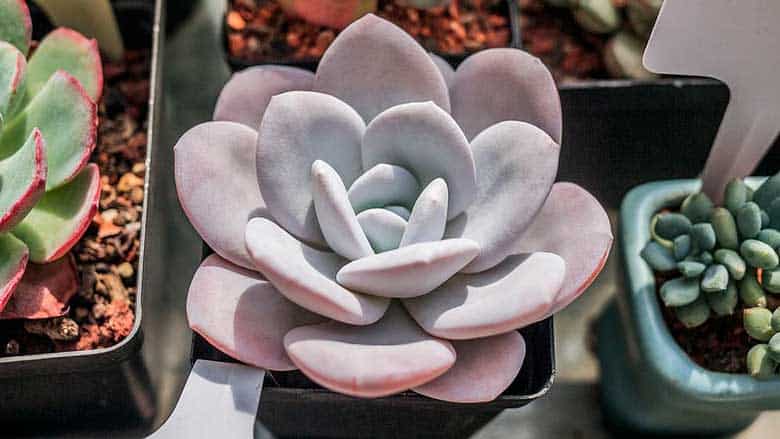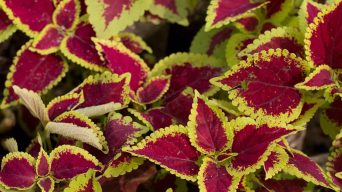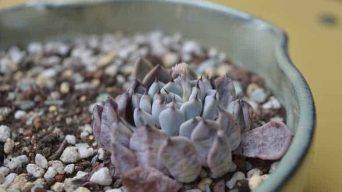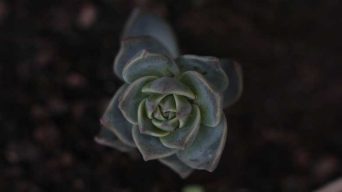Powdery mildew is a common fungal disease that takes over succulent plants.
It can be difficult to treat powdery mildew because it spreads so quickly.
However, there are some easy steps you can take to get rid of powdery mildew on your succulents!
In this blog post, we will go into detail about how to identify powdery mildew and the different treatments that could work for your succulent plants.
You will find all the information you need to successfully remove powdery mildew from your succulents without too much trouble or time!
What Is Powdery Mildew
Powdery mildew is a fungal disease that occurs when the powdery white substance appears on your succulents.
It can cause leaves to yellow and curl, or it may affect flowers too, depending on the variety.
Powdery mildew will often appear as a powdery white substance on the top of your succulents.
It is usually quite obvious, and you should be able to spot it from a few feet away, which makes treating powdery mildew relatively easy.
Powdery mildew is a common problem for succulent owners because powdery mildew likes warm, moist places to grow.
Since succulents like the same conditions, powdery mildew can easily spread from plant to plant if you’re not careful.
What Causes Powdery Mildew on Succulents
Powdery mildews are most common during wet weather that isn’t particularly hot or cold.
They spread quickly in humid conditions, so they tend to affect plants with poor air circulation more than others – although they can infect any plant.
As well as being affected by humidity, powdery mildews also need high levels of nitrogen within the soil for them to grow. So if you have been giving your succulents too much fertilizer, this could cause powdery mildew to grow.
Also, powdery mildew can be caused by powdery mildews being carried around on an infected plant, so if you have any plants in the same family as your succulents, they could transfer powdery mildew to them.
Fungal powdery mildew is considered the most common plant disease in temperate regions. Powdery mildew on succulents is a highly contagious fungal infection that can spread rapidly and cover your plants.
Why Do Succulents Get Powdery Mildew
Succulents are very low-maintenance plants that require little care to grow.
However, powdery mildew fungi is extremely common among succulent growers and can wipe out an entire collection in days if it’s not treated promptly!
Succulents are susceptible to powdery mildew for a few reasons.
First, powdery mildew loves warm, moist conditions, so it is most likely to attack succulents in the summer when it’s hot and humid or indoors with poor air circulation.
Second, powdery mildew grows by germinating spores that float through the air from plant to plant.
This means that any succulent you bring into your home could potentially infect your entire collection without proper precautions!
What Does Powdery Mildew On Succulents Look Like
Powdery mildew on most plants looks like a white powder growing over the surface of leaves, but this is not always true for succulents because they have thick waxy skin instead of delicate thin leaves.
Powdery mildew on succulents can look like several different things.
- Powdery white coating over leaves and stems
- Powdery white powder on the soil
- Powdery mildew can appear as a crust or film on leaves and stems, sometimes with an extreme color change from green to yellow or red.
Symptoms of powdery mildew include white powder or patches forming over leaves and stems – this looks similar to dust but will rub off, unlike natural dirt, which has been left there long term.
It usually appears first at the bottom of the plant, where it is most wet from watering and spreads upwards until all parts are affected.
The leaf surface may also appear brownish underneath these powder patches, with some yellowing spots appearing throughout older growths, too – although this isn’t always present.
Powdery mildew tends not to affect the roots of a plant.
What Damage Can Powdery Mildew Cause
Powdery mildew on succulents doesn’t usually kill plants, but it can cause severe damage.
The powder is made up of a fungus that spreads quickly and blocks out light from leaves, so they start to turn yellow and die.
This means powdery mildew won’t just damage your plant’s looks- it could also stunt its growth or stop new flowers blooming too!
Fungal spores are also released when powdery mildew is around, which could infect other plants in your garden.
Succulents with powdery mildew may also attract other pests, such as mealybugs, spider mites, and aphids.
How To Get Rid of Powdery Mildew on Succulents
You can use several effective powdery mildew treatment methods depending on what type of succulent you have and how bad your powder problem is.
The following powdery mildew treatment techniques are proven to be effective powdery mildew remedies for succulent plants.
Neem Oil
Neem Oil is a powdery mildew killer that you can use on your succulents.
Just mix one tablespoon of neem oil into a gallon of water and pour the solution onto your plants every two weeks until powdery mildew disappears from your succulent plant leaves.
Dish Soap and Water
Dish soap and water works very well.
Just mix a few drops of dish soap with some warm water in a spray bottle.
Shake the mixture to make sure it is mixed up well and then apply it on your succulent leaves using either an eye dropper for small plants or use the spray nozzle attachment if you have one.
This powdery mildew treatment method will kill powdery mildew fast but be careful not to get any dish soap solution into the soil because this can damage roots.
Baking Soda
Baking soda powdery mildew treatment works well.
Just add one tablespoon of baking soda into a gallon of water and then spray the mixture onto your succulent leaves every two weeks until powdery mildews are gone from your plants.
Hydrogen Peroxide
Mix one teaspoon of hydrogen peroxide powder into a half-gallon of water. Then spray the solution onto your succulent plant leaves every two weeks until powdery mildews are gone.
It is best to mix up new hydrogen peroxide solutions for each application because it will lose its potency after several days once mixed with water.
Insecticidal Soap or Horticultural Oil Spray
When using insecticidal soap or horticultural oil sprays, mix one tablespoon of powder into a gallon of water.
Apply the solution onto your succulent leaves using either an eye dropper for small plants or use the spray nozzle attachment if you have one.
Applying powdery mildew treatments in this manner will kill powdery mildew fast, and be careful not to get any powder mixture into the soil because it can damage roots.
Remove Powdery Mildew Infected Leaves
Remove powdery mildew from plant leaves by getting rid of powder-covered leaves as soon as you see powder on them.
This will prevent the infection from spreading to other healthy succulent plants and help stop an infestation if caught early enough.
Mouthwash
Mouthwash powdery mildew treatment works very well.
Just mix a few drops of mouthwash into a gallon of water and use the solution to spray your succulent leaves every two weeks until powdery mildews are gone from your plants.
The mouthwash powder mixture is as effective as many other commercial powder treatments. Still, it also makes them taste like mint, which helps prevent deer, rabbits, raccoons, and squirrels from eating all of your succulents!
What Can Be Done To Control the Spread of Powdery Mildew
When your succulent is infected with powdery mildew, you should remove it from the rest of your collection as soon as possible.
If that isn’t feasible at the moment, try to isolate it from them so they cannot come into contact with each other.
It’s also good to sterilize any tools or containers used when working around one plant and not others; this helps prevent spreading the mold spores even further!
The infection probably won’t spread to the rest of your collection on its own, but you do need to keep an eye out for other symptoms.
If any more plants show signs of powdery mildew later, quarantine them immediately, so it doesn’t have a chance to progress!
The spread of powdery mildew can also be controlled by pruning off any leaves with the infection and immediately discarding them.
It’s a good idea to discard the leaves in a closed garbage bag so that spores can’t escape and infect other plants, as well as sterilize any tools you use after working with those infected leaves before using them on healthy ones!
You should also carefully monitor your succulents for signs of powdery mildew.
If you notice anything suspicious early enough, chances are much higher than it will be completely treatable without having spread too far out already.
How To Prevent Powdery Mildew on Succulents
Powdery mildew is a condition caused by fungi where white spots start showing up on the surface of succulents.
This fungus thrives in moist environments, so you should ensure that your plants don’t stay wet for too long and dry out between watering sessions.
Usually, if powdery mildew appears, it means that there was an issue with the humidity or moisture level at some point during plant life which allowed this infection to spread through spores into healthy plant tissue.
Powdery mildews are not deadly, but they can result in stunted growth and reduction of flowers and leaves turning yellow and dropping off prematurely.
The best way to prevent powdery mildew infections is to ensure that your plants have access to proper sunlight, air, and water.
Succulents like bright sunlight but are not directly exposed to the hot afternoon sun.
Ensure they get at least six hours of fresh air daily, and don’t allow water to collect on their leaves or sit in saucers for too long.
Also, remember to clean up any dead leaves and stems that may have fallen off, as these can be a breeding ground for powdery mildew spores.
If you do happen to notice white mold on your succulent plant, it’s important not to panic and give the plant too much water or fertilizer in an attempt to fix the problem.
It’s also important to avoid overhead watering whenever possible because standing moisture favors fungal infections like powdery mildews over bacterial ones, which require direct contact with plants instead.
Powdery mildew is a common problem for succulents. Once they have been infected, it’s essential to keep the humidity levels down so that you don’t accidentally further spread this infection.
Final Thoughts
Powdery mildew on succulents is a very easy disease to treat if caught early.
If you’ve been cultivating indoor succulents or in any enclosed space for an extended period, make sure you check to see if they have powdery mildew before moving them outside, where the spores will spread more easily.
Remember that prevention is always better than cure, so keep an eye out for healthy-looking succulent leaves with yellow or brown spots, which may mean they’re infected by powdery mildew!
It can spread rapidly across multiple succulent varieties in a few days if not treated quickly!







